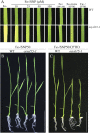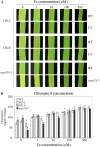Disruption of OsYSL15 leads to iron inefficiency in rice plants
- PMID: 19376836
- PMCID: PMC2689993
- DOI: 10.1104/pp.109.135418
Disruption of OsYSL15 leads to iron inefficiency in rice plants
Abstract
Uptake and translocation of metal nutrients are essential processes for plant growth. Graminaceous species release phytosiderophores that bind to Fe(3+); these complexes are then transported across the plasma membrane. We have characterized OsYSL15, one of the rice (Oryza sativa) YS1-like (YSL) genes that are strongly induced by iron (Fe) deficiency. The OsYSL15 promoter fusion to beta-glucuronidase showed that it was expressed in all root tissues when Fe was limited. In low-Fe leaves, the promoter became active in all tissues except epidermal cells. This activity was also detected in flowers and seeds. The OsYSL15:green fluorescent protein fusion was localized to the plasma membrane. OsYSL15 functionally complemented yeast strains defective in Fe uptake on media containing Fe(3+)-deoxymugineic acid and Fe(2+)-nicotianamine. Two insertional osysl15 mutants exhibited chlorotic phenotypes under Fe deficiency and had reduced Fe concentrations in their shoots, roots, and seeds. Nitric oxide treatment reversed this chlorosis under Fe-limiting conditions. Overexpression of OsYSL15 increased the Fe concentration in leaves and seeds from transgenic plants. Altogether, these results demonstrate roles for OsYSL15 in Fe uptake and distribution in rice plants.
Figures











Similar articles
-
Rice OsYSL15 is an iron-regulated iron(III)-deoxymugineic acid transporter expressed in the roots and is essential for iron uptake in early growth of the seedlings.J Biol Chem. 2009 Feb 6;284(6):3470-9. doi: 10.1074/jbc.M806042200. Epub 2008 Dec 2. J Biol Chem. 2009. PMID: 19049971
-
OsYSL16 plays a role in the allocation of iron.Plant Mol Biol. 2012 Aug;79(6):583-94. doi: 10.1007/s11103-012-9930-1. Epub 2012 May 29. Plant Mol Biol. 2012. PMID: 22644443 Free PMC article.
-
The iron-chelate transporter OsYSL9 plays a role in iron distribution in developing rice grains.Plant Mol Biol. 2017 Nov;95(4-5):375-387. doi: 10.1007/s11103-017-0656-y. Epub 2017 Sep 4. Plant Mol Biol. 2017. PMID: 28871478
-
The Adaptive Mechanism of Plants to Iron Deficiency via Iron Uptake, Transport, and Homeostasis.Int J Mol Sci. 2019 May 16;20(10):2424. doi: 10.3390/ijms20102424. Int J Mol Sci. 2019. PMID: 31100819 Free PMC article. Review.
-
The Molecular Mechanisms Underlying Iron Deficiency Responses in Rice.Int J Mol Sci. 2019 Dec 19;21(1):43. doi: 10.3390/ijms21010043. Int J Mol Sci. 2019. PMID: 31861687 Free PMC article. Review.
Cited by
-
The road to micronutrient biofortification of rice: progress and prospects.Front Plant Sci. 2013 Feb 8;4:15. doi: 10.3389/fpls.2013.00015. eCollection 2013. Front Plant Sci. 2013. PMID: 23404425 Free PMC article.
-
A rapid and efficient method to study the function of crop plant transporters in Arabidopsis.Protoplasma. 2017 Mar;254(2):737-747. doi: 10.1007/s00709-016-0987-6. Epub 2016 May 30. Protoplasma. 2017. PMID: 27240439
-
Characterizing the crucial components of iron homeostasis in the maize mutants ys1 and ys3.PLoS One. 2013 May 8;8(5):e62567. doi: 10.1371/journal.pone.0062567. Print 2013. PLoS One. 2013. PMID: 23667491 Free PMC article.
-
Effects of exogenous gibberellic acid3 on iron and manganese plaque amounts and iron and manganese uptake in rice.PLoS One. 2015 Feb 24;10(2):e0118177. doi: 10.1371/journal.pone.0118177. eCollection 2015. PLoS One. 2015. PMID: 25710173 Free PMC article.
-
Enriching rice with Zn and Fe while minimizing Cd risk.Front Plant Sci. 2015 Mar 12;6:121. doi: 10.3389/fpls.2015.00121. eCollection 2015. Front Plant Sci. 2015. PMID: 25814994 Free PMC article. Review.
References
-
- An G, Ebert PR, Mitra A, Ha SB (1988) Binary vectors. In SB Gelvin, RA Schilperoort, eds, Plant Molecular Biology Manual. Kluwer Academic Publishers, Dordrecht, The Netherlands, pp A3/1–A3/19
-
- Anbar M (1995) Nitric oxide: a synchronizing chemical messenger. Experientia 51 545–550 - PubMed
-
- Bashir K, Inoue H, Nagasaka S, Takahashi M, Nakanishi H, Mori S, Nishizawa NK (2006) Cloning and characterization of deoxymugineic acid synthase genes from graminaceous plants. J Biol Chem 281 32395–32402 - PubMed
Publication types
MeSH terms
Substances
Associated data
- Actions
LinkOut - more resources
Full Text Sources
Medical

